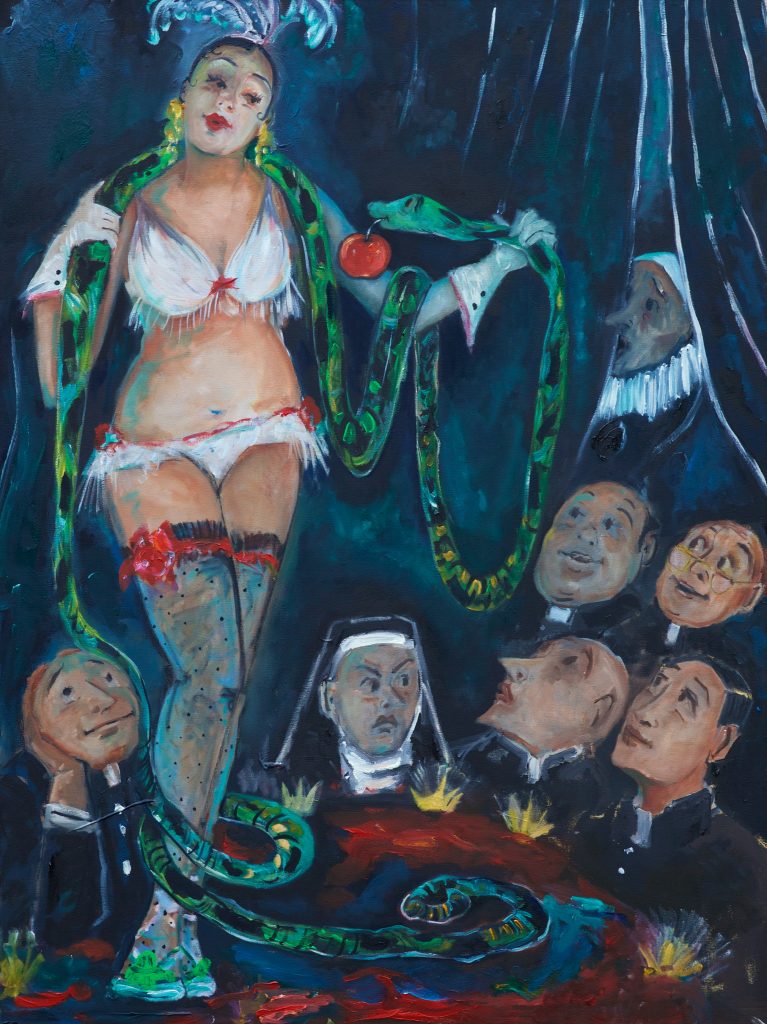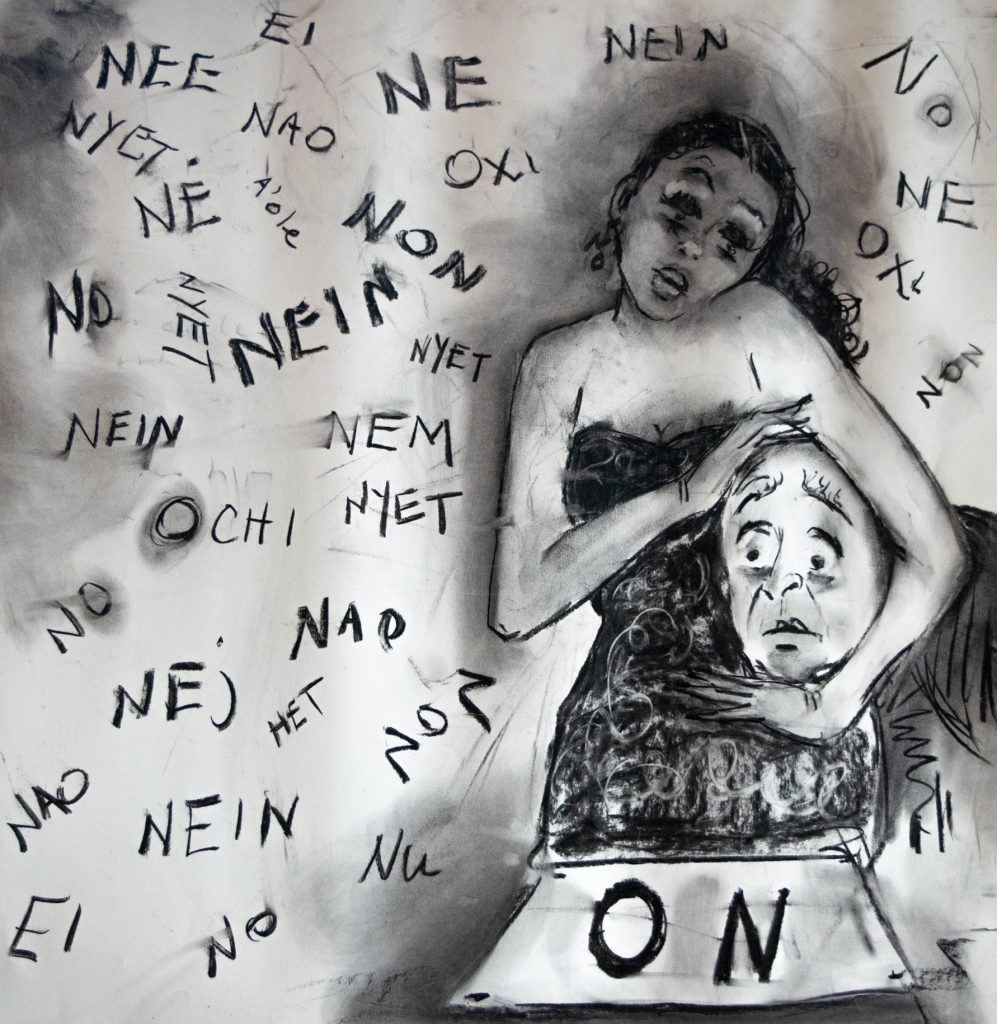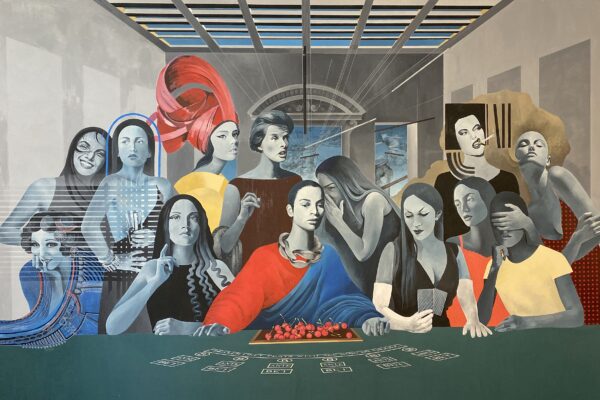Henri de Toulouse-Lautrec lives. So does the bawdy, libertine spirit of the Moulin Rouge, its eroticism and joie de vivre. The boundless imagination, and caressing fingertips of Lautrec’s heir apparent, the voluptuous dancers and decadent spirit of the Cancan comes back to life. Always intimately, vividly and provocatively. Through the color sketching of an Italian seamstress’ daughter, Anna Mazzotta. A navigator, she explores the subterranean recesses of Glamour, its surprises, suspense, and darker fantasies–with her fingers.
-

Anna Mazzotta -

Reimagining the sinfulness of Toulouse-Lautrec’s world, caricaturist Mazzotta explains, “my using paint brushes just wouldn’t work. They are too distant from me, from my inner feelings. I want to connect with the canvas. Really connect. I must feel myself painting…or my using very versatile charcoal. I need that touch on the canvas….I need to feel the energy of my work.”

That passion to create was partially inherited from her mother, a woman who was enthralled by Hollywood, starlets, and the allure of “Old School” movies. Mazzotta listened to her speaking about Grace Kelly, Cary Grant, and was forever committed to precisely “stitching” her own fantasies.
Mazzotta’s desire to paint, to experience the past sensations of Rabelaisian worlds, also traces back to burlesque, Billie Holiday, Alfred Hitchcock and other classical black and white movies (“they are the best,” she declares, listing Rebecca, Psycho and Dial M for Murder as some of her favorites). There was “real life back then, authentic exhilaration,” she muses, admitting there was also a mournfulness at the heart of Cabaret life.

Hollywood inspired her. She became passionately attached to its leading stars, and was charmed by her own versions of Cinema Paradiso. But the deft movements of her hands, the virtuosity that allows her to turn oil paints and charcoal into renderings of complex emotions comes from studying her mother Francesca.“Always inquisitive, I loved seeing her touch fabrics with such gentility and precision,” reminisces Mazzotta in her Wiltshire, UK studio, surrounded by a mannequin, art books, a large mirror, and an evocative Ginger Rogers-Fred Astaire movie poster.

“She loved the past. She would talk about fashion, about the dresses worn by the beautiful women in Hollywood. I guess that’s why I like dressing my characters, why I am fascinated by the film and entertainment world…I see my work as film, short vignettes…they too are stories, organic, always unfolding and evolving.”But Puglia is a long way from the Moulin Rouge and Parisian dance halls filled with show girls in layered petticoats. There was no magic in Puglia, Italy. Certainly not the type Mazzotta savored in Hollywood spectaculars, or in the “carefully-staged dramas” of another admired performer, Houdini.
Determined to find her own bright lights, Mazzotta attended London’s prestigious Royal College of Art. Suddenly thrust into a world of limitless possibilities, she considered a career in fashion and set design (“I feel like a director now…I choose the sets, makeup, the protagonists…I feel in complete control”). Her indecision quickly ended once she won one of the UK’s highest honors.
Selected as the Jerwood Prize winner from among 1000 other artists, she immediately felt “validated, confident” about her style and vision. Her winning charcoal-sketched entry, Three Women, depicted women with masks (characters in masks, literally and metaphorically, are a constant theme in her work). Troubled by their ugliness, these desperate women hope to entice men with artifice, and other ruses.

It’s enchantment juxtaposed with mischievous deviltry, what Mazzotta terms, “Beauty and seduction mixed with naughtiness, my cheekiness, but still realistic, women not being free.” Or as is clearly suggested, what women suffer struggling to find acceptance and equality. Lifting the masks on other women, Mazzotta delves deep into the Human Condition, not just the disappointments, joys, and earthiness of cafe life. She plunges into far deeper terrain. Mazzotta also looks at herself, boldly investigating all her emotions–the complexities of being an artist, from exhilaration to searing disappointments. She’s revealing in the same unrelenting style as Alfred Hitchcock entered the personalities of his characters. This famed master of suspense exposed their frailties, perversions and fears–to make us have our own reckonings, to force us to deal with our own demons.

Impelled to create suspense, theatrics, she too is a voyeur, amusing and unsettling us, picturing a woman enclosed in a keyhole, for example, distressed by the looming threat of entering a male refuge. What will befall her, we are forced to wonder? Will she surrender to a man’s fantasies, descend deeper into the dread that lurks behind the door? “My characters are part of me, my humor, my pain, my fears, and they are all survivors, they experience what I have,” explains Mazzotta, who has done commissioned work for Jane Fonda, jazz pianist Jamie Cullum, and musician-turned-DJ Fat Boy Slim. “I wanted the woman in the keyhole to be a real person, surprised by life. She’s wondering what the future holds, especially now that we are facing the troubling questions posed by the Pandemic. Feeling isolated by this scourge in our midst, unable to engage with her “life force” in cafes and clubs, she could be expected to feel restricted, her imagination limited by keyholes.

It’s not. Through her deft fingertips, Mazzotta remains buoyant, the compassionate, cinematic painter, ever weaving tapestries of lives living dangerously. Eager to see Mazzotta at work, to understand her creative process, LSA “daringly” visited Mazzotta’s “big mess,” a studio crammed with charcoal boxes, mounds of Fabriano paper, torn-out pages of magazines, random drawings, cloths, brushes and paint-splashed walls.
LSA: The artist at work, your studio, I see it mirrors your “cheeky” and flamboyant style.
A.M: I like harkening back to the past, that spirit in art is rare today. Too many gimmicks. I am the purist, and I like going against the grain.
LSA: There are a lot of women in your work.
AM :In general, they reflect part of me. I am at times confused, but I am strong, I also have power.

LSA: Are these feelings expressed in your charcoal drawing, The Man Who Didn’t Understand No?
AM :The word ‘No’ appears in many languages because this man who pursued me romantically just didn’t leave me alone. I said ‘No’ forcefully. He didn’t get it. So I pictured a woman having a man in a headlock. It’s a statement of independence, women being free.
LSA: Women also seem disappointed in some of your work.

AM; Promises have been made to me, and never fulfilled. Agents make lots of promises, there are a lot of cons in the art world. I was sheltered in college, I didn’t expect these cons, but I have learned from my mistakes. The lies are disillusioning, but I still see the beauty in people, in my characters.
LSA: These women also seem to be waiting, expecting that there’s something lurking, a change in their lives, even danger.
AM: That’s Hitchcock. Characters surprised by life. I love to paint vivid expressions. The UK is gray. I want people to escape the grayness.
LSA: Your Cake Factory is certainly colorful.
AM:That is part of a series, the 7 Deadly Sins, this is one is about Gluttony. Just eating for eating’s sake. I am being nice to these women. They are cake tasters, unaware of a never- ending supply from an invisible baker. I like picturing what you don’t see.

LSA: Your Black Widow’s Catch, she’s holding a fish, also seems sinful. A bit macabre.
AM:This is my tribute to Hitchcock and film noir She murdered her husband and feeling free. The fish is a man, and now she is on to her next man, her next catch.

LSA: Fish are prominent in your work.
AM; My mother loved dolphins. I don’t know if they are a substitute for men. Maybe they are less threatening than men.
LSA: You told me that you enjoy listening to music while you work. There is no music being played in The Speakeasy: How Could Something So Wrong, Feel So Right. You picture a woman sitting on a piano, a woman who looks very animated, delighted by her surroundings
AM: watching…she is important, happy. We need music, we need culture. Otherwise we are living in a jungle. I feel the music when I paint. But there is a lack of music during the Pandemic. No music…just isolation.







